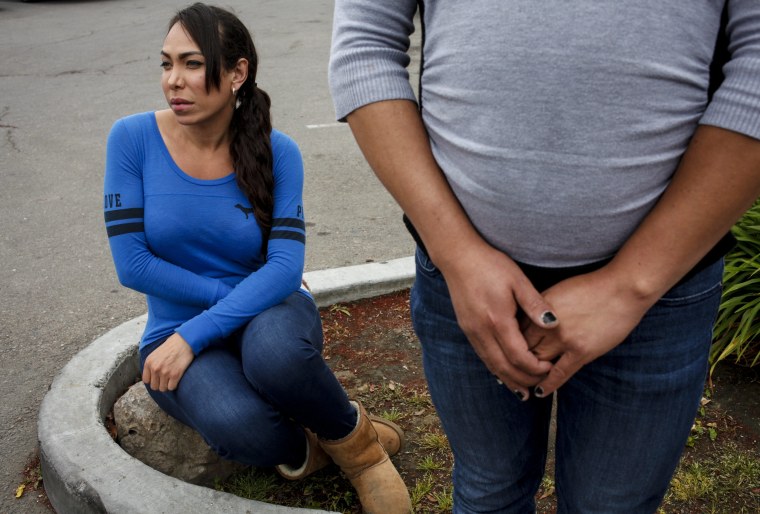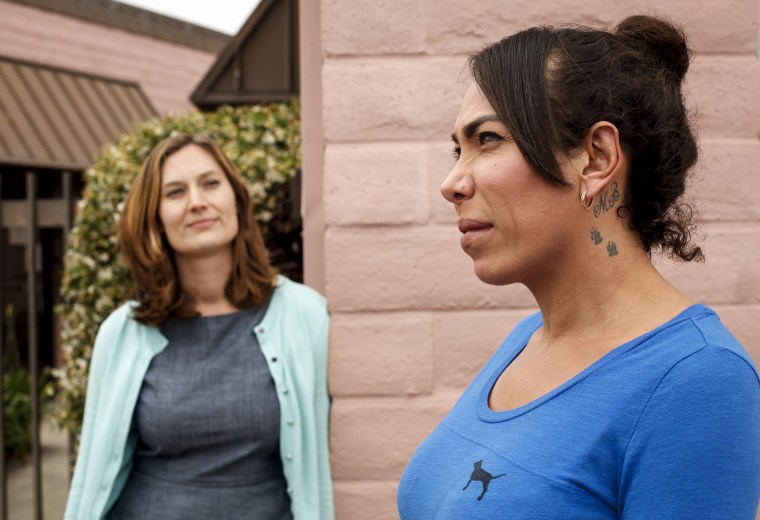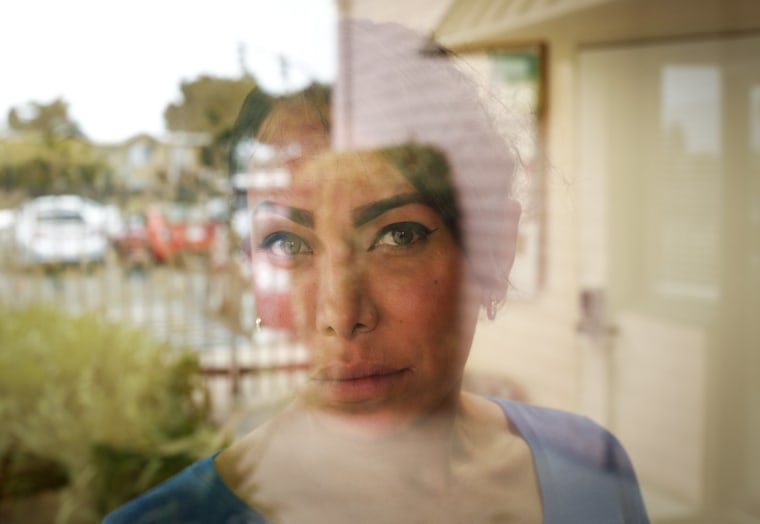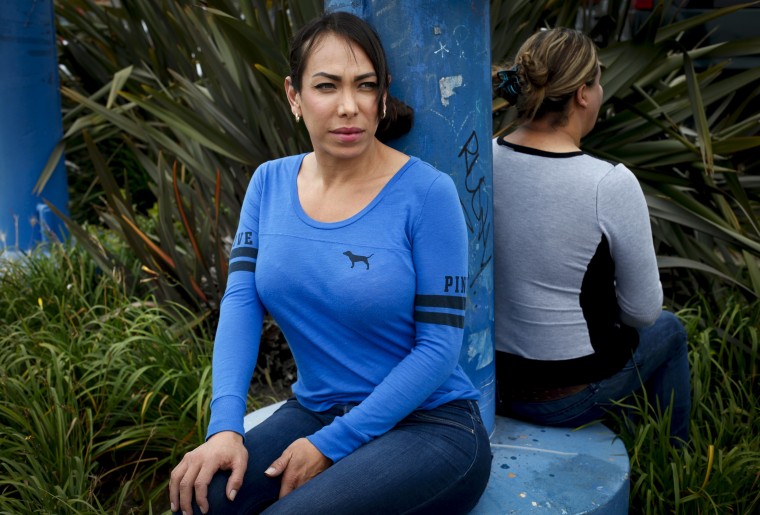“You need to talk to more women like us,” Valery tells Flora. She is insistent that Flora know her rights. At the moment, they’re seated in a conference room of the California Rural Legal Assistance (CRLA) office in Salinas, California.
Both are in their 30s. Both are farmworkers in the Salinas area, a coastal offshoot of California’s rural and predominantly agricultural Central Valley. Recognizing at an early age that they are transgender, they emigrated to the United States separately, in their teens, to flee the “terrible” conditions – harassment, abuse, violence and rejection – that often accompany being transgender in Mexico.
“No estás solita,” Valery tells Flora. You are not alone.
This is the first time they have met. It is also the day Flora learns that in the state of California she has the legal right to use the bathroom that corresponds to her gender identity.

Flora works at a produce packaging facility in California, where she packages broccoli and other seasonal produce for distribution. She’s is in the “difficult” early stages of her transition. She is friendly yet reserved. Her coworkers are generally “very supportive” of her; they refer to her affectionately as “chica” (girl). However, management requires her to use the men’s bathroom, because the name on her working papers is male.
Valery, by comparison, is 34, confident and energetic, although she admits to being shy in large gatherings. She works on a lettuce farm, packing heads of lettuce as workers and equipment move through the fields. She came to the U.S. at the age of 18 so she could “be who I am.”
When Valery first started working in the U.S., she felt she had to hide who she was. The makeup and clothes would come out at night, after work. Over time she gained more confidence - especially after discovering CRLA.

“They changed my life,” Valery says. CRLA helped her legally change the name and gender on her work documents, and for the last six years she has been living and working fully as her true self: as Valery. Recently, she’s embarked on a new path of transgender activism and education, motivated in large part by her involvement in CRLA’s LGBT program in Salinas.
But it isn’t easy, she admits. “Every day is a battle to be trans in the Latino community.” Particularly in the neighboring Central Valley.
The Central Valley is vast. Eleven million acres of mostly agricultural land stretch 450 miles from Sacramento to Los Angeles. The Valley is heavily Latino - 38 percent, according to 2014 U.S. Census data. In the southern portion of the Valley that number increases to 51 percent.
"The undocumented community … is one that lives in the shadows, that plugs away silently at daily life hoping not to bring any unnecessary attention to themselves. Couple that with a culture which does not easily accept or value an LGBTQ lifestyle … and you find a number of Latinos hiding or suppressing their sexual identity.”
The Central Valley is also politically conservative. The Public Policy Institute of California reports the highest percentage of voting Republicans in the state live in the Central Valley. In 2008, voters in nine Central Valley counties voted nearly three to one in favor of Prop 8, which banned same-sex marriage in California.
There are approximately 900,000 LGBT immigrants living in the United States today, and an estimated 267,000 of them are undocumented, according to a study conducted by the Williams Institute at UCLA. The Williams Institute estimates 71 percent of those who are undocumented are Hispanic. Many of these immigrants, like Valery and Flora, are lawfully able to work but their long-term immigration status is uncertain.
According to Juan Luis Guzman, a poet, English professor and adviser to the LGBT student association at Fresno City College, “The undocumented community … is one that lives in the shadows, that plugs away silently at daily life hoping not to bring any unnecessary attention to themselves. Couple that with a culture which does not easily accept or value an LGBTQ lifestyle … and you find a number of Latinos hiding or suppressing their sexual identity.” This yields "layers of invisibility," adds Guzman.

Local organizations are trying to peel back those layers of invisibility. CRLA specializes in providing legal access and civic engagement opportunities for rural LGBT communities. Fresno’s City College reaches out to undocumented immigrants to inform them about AB540, a California law that allows certain non-resident students to pay in-state tuition at state colleges and universities. The Bakersfield chapter of PFLAG recently held its first Spanish-language meeting for parents and their LGBT children.
Community outreach and state regulations, however, only go so far. But U.S. immigration law is vast and complex - more complex, according to many immigration advocates, than the U.S. tax code. It is unsurprising, then, that many immigrants - like Flora - are unaware of their rights.
Aaron Morris, executive director of Immigration Equality, an LGBTQ immigration rights organization, says the system is “stacked against” the very people“we should be working hardest to protect.”
Asylum requests, for instance, must be made within one year of arriving in the U.S., unless the petitioner is able to prove extenuating circumstances. Moreover, immigrants who request asylum at the border are immediately taken into detention. “It becomes infinitely difficult to get asylum under these conditions," adds Morris.
Undocumented immigrants who have been victims of crime – and transgender individuals are especially susceptible – may be eligible for U Nonimmigrant Status, which allows them to stay in the U.S. for four years, with the possibility of extending.
RELATED: Supreme Court Tie Dooms Obama Immigration Policy
However, the recent Supreme Court deadlock in U.S. v. Texas - which would have shielded millions of immigrants from deportation - leaves many of them in "limbo," according to Morris.
Nevertheless, Valery says “we are many," referring to the number of transgender immigrants in the Central Valley. For her, her mother back in Mexico is “her foundation,” and CRLA in the U.S. is her inspiration. She believes that she and women like Flora are at the beginning of “algo differente, algo mas” – something different, something more – not just individually, but for the immigrant LGBT community at large.
*Valery and Flora are pseudonyms and certain details about their lives have been changed in order to protect their privacy.
